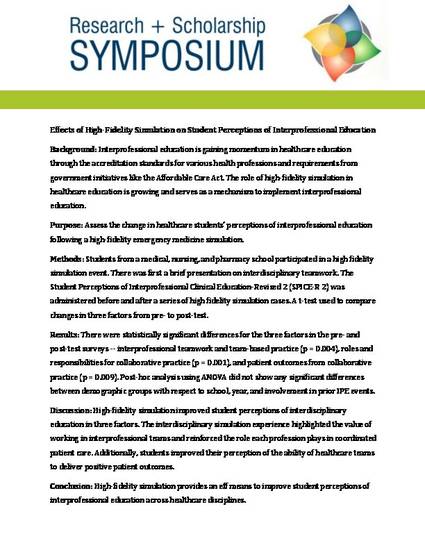
- Interprofessional education,
- collaborative practice,
- professional roles,
- student perceptions,
- high-fidelity simulation,
- healthcare education,
- medical,
- pharmacy,
- nursing
Background: Interprofessional education is gaining momentum in healthcare education through the accreditation standards for various health professions and requirements from government initiatives like the Affordable Care Act. The role of high-fidelity simulation in healthcare education is growing and serves as a mechanism to implement interprofessional education.
Purpose: Assess the change in healthcare students’ perceptions of interprofessional education following a high-fidelity emergency medicine simulation.
Methods: Students from a medical, nursing, and pharmacy school participated in a high fidelity simulation event. There was first a brief presentation on interdisciplinary teamwork. The Student Perceptions of Interprofessional Clinical Education-Revised 2 (SPICE-R 2) was administered before and after a series of high fidelity simulation cases. A t-test used to compare changes in three factors from pre- to post-test.
Results: There were statistically significant differences for the three factors in the pre- and post-test surveys -- interprofessional teamwork and team-based practice (p = 0.004), roles and responsibilities for collaborative practice (p = 0.001), and patient outcomes from collaborative practice (p = 0.009). Post-hoc analysis using ANOVA did not show any significant differences between demographic groups with respect to school, year, and involvement in prior IPE events.
Discussion: High-fidelity simulation improved student perceptions of interdisciplinary education in three factors. The interdisciplinary simulation experience highlighted the value of working in interprofessional teams and reinforced the role each profession plays in coordinated patient care. Additionally, students improved their perception of the ability of healthcare teams to deliver positive patient outcomes.
Conclusion: High-fidelity simulation provides an eff means to improve student perceptions of interprofessional education across healthcare disciplines.
Available at: http://works.bepress.com/mckenzie-shenk/2/
